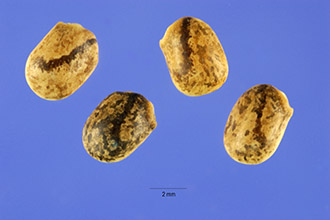Elegant Lupine
Scientific Name: Lupinus elegans Kunth

| General Information | |
|---|---|
| Usda Symbol | LUEL4 |
| Group | Dicot |
| Life Cycle | |
| Growth Habits | |
| Native Locations | LUEL4 |
Plant Guide
Use soil moisture sensors to measure the soil moisture of Elegant Lupine.
Fact Sheet
Alternate Names
Mexican lupine
Uses
This legume has shown considerable promise as a winter cover crop, It produces good to excellent ground cover in young irrigated citrus groves, and is an excellent producer of honey nectar, , Use soil moisture sensors to measure the soil moisture of Elegant Lupine.
Status
Please consult the PLANTS Web site and your State Department of Natural Resources for this plant’s current status (e.g. threatened or endangered species, state noxious status, and wetland indicator values).
Description
Lupinus elegans Kunth, elegant lupine, grows to a height of 4 feet and is 3 feet wide. Growth is from a central stem which branches frequently. The blooming period lasts for several weeks, commencing about mid-January and continuing to late March. Overall seed production is good, but the amount available for harvest at any one time is rather limited as the seed pods shatter readily upon reaching maturity. The seed produced is small, hard, persists in the soil, and volunteers readily in the autumn months.
Adaptation and Distribution
Distribution
Distribution
Elegant lupine is adapted to fine and medium textured soils with moderate fertility and a pH of 6 to 7. The species has some drought tolerance, but prefers a minimum of 35 inches of annual precipitation to grow. For a current distribution map, please consult the Plant Profile page for this species on the PLANTS Website.
Establishment
Plow and/or disk the soil thoroughly and follow by firmly packing the soil while it is still moist. Fertilize at the recommended rate at or prior to seeding. Twenty-five pounds of seed per acre are required for broadcast seedings, while 12 to 15 pounds per acre should be used for row planting. Row planting results in more satisfactory inoculation and more rapid early growth. Inoculation is required regardless of planting method. Pack the soil firmly over either broadcast or row planted seed.
Management
This lupine can withstand moderate drought, but will grow considerably better if supplemental irrigation can be provided during drought periods. Seed harvesting occurs from mid-March to mid-April depending upon location, soil, weather and plant conditions. The seed is harvested while much of the plant is still green. The crop is mowed when the optimum amount of nearly mature seed is present and is allowed to dry on the ground. When the leaves, pods and stalks are nearly dry, the material is run through a conventional seed harvesting combine.
Plant Traits
Growth Requirements
| Temperature, Minimum (°F) | 47 |
|---|---|
| Adapted to Coarse Textured Soils | No |
| Adapted to Fine Textured Soils | Yes |
| Adapted to Medium Textured Soils | Yes |
| Anaerobic Tolerance | None |
| CaCO3 Tolerance | None |
| Cold Stratification Required | No |
| Drought Tolerance | Low |
| Fertility Requirement | Medium |
| Fire Tolerance | None |
| Frost Free Days, Minimum | 180 |
| Moisture Use | Medium |
| pH, Maximum | 7.0 |
| pH, Minimum | 6.0 |
| Precipitation, Maximum | 60 |
| Precipitation, Minimum | 35 |
| Root Depth, Minimum (inches) | 10 |
| Salinity Tolerance | None |
| Shade Tolerance | Intolerant |
Morphology/Physiology
| Bloat | Low |
|---|---|
| Toxicity | Moderate |
| Shape and Orientation | Erect |
| Nitrogen Fixation | High |
| Resprout Ability | No |
| Active Growth Period | Fall, Winter and Spring |
| C:N Ratio | Low |
| Coppice Potential | No |
| Fall Conspicuous | Yes |
| Fire Resistant | No |
| Flower Color | Blue |
| Flower Conspicuous | Yes |
| Foliage Color | Green |
| Foliage Porosity Summer | Porous |
| Fruit/Seed Color | White |
| Fruit/Seed Conspicuous | Yes |
| Growth Form | Single Crown |
| Growth Rate | Rapid |
| Height, Mature (feet) | 3.0 |
| Known Allelopath | No |
| Leaf Retention | No |
| Lifespan | Short |
| Low Growing Grass | No |
| Foliage Texture | Medium |
Reproduction
| Propagated by Seed | Yes |
|---|---|
| Propagated by Sod | No |
| Propagated by Sprigs | No |
| Propagated by Bare Root | No |
| Propagated by Tubers | No |
| Seed per Pound | 2200 |
| Seed Spread Rate | Moderate |
| Seedling Vigor | Medium |
| Small Grain | No |
| Vegetative Spread Rate | None |
| Propagated by Corm | No |
| Propagated by Container | No |
| Propagated by Bulb | No |
| Fruit/Seed Persistence | Yes |
| Fruit/Seed Period End | Fall |
| Fruit/Seed Period Begin | Summer |
| Fruit/Seed Abundance | Low |
| Commercial Availability | No Known Source |
| Bloom Period | Late Summer |
| Propagated by Cuttings | No |
Suitability/Use
| Veneer Product | No |
|---|---|
| Pulpwood Product | No |
| Protein Potential | Medium |
| Post Product | No |
| Palatable Human | No |
| Palatable Graze Animal | Low |
| Palatable Browse Animal | Low |
| Nursery Stock Product | No |
| Naval Store Product | No |
| Lumber Product | No |
| Fodder Product | No |
| Christmas Tree Product | No |
| Berry/Nut/Seed Product | No |
